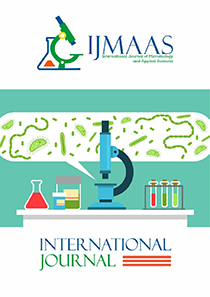Phytochemical Constituents and Antimicrobial Activity of Various Concentrations of Ethanolic Extracts of Different Plant Parts of Ocimum gratissimum
Vol 2, Issue 2, 2023
KEYWORDS
Ocimum gratissimum, plant parts, aqueous extracts, antimicrobial activity, bacteriostatic, fungicidal
Abstract
Recent trend of high percentage of microbial resistance to conventional antibiotics necessitates intensified efforts towards the search for more sources of antimicrobial agents. This study investigated phytochemicals and antimicrobial activity of aqueous extracts of Ocimum gratissimum against Staphylococus aureus and Candida albicans using standard techniques. Phytochemical screening of Ocimum gratissimum extracts indicates presence of alkaloids, flavonoids, tannins, saponnins, cardiac glycosides, and phlobatannins. This showed that Ocimum gratissimum produces secondary metabolites that make the plant useful in medicine. Alkaloids, tannins and phlobatannins were absent in the seeds while flavonoids was absent in the stem. Antimicrobial activity of Ocimum gratissimum against Staphylococcus aureus and Candida albicans using agar well diffusion method showed zones of inhibition of Leaf extract against Staphylococcus aureus at 100mg/ml, 50mg/ml and 25mg/ml concentrations were 22.00±0.26mm, 20.00±0.26mm and 16.00±0.26mm respectively. Zones of inhibition of Seed extract against Staphylococcus aureus at 100mg/ml and 50mg/ml were 20.00±0.26mm and 18.00±0.26mm respectively. Zones of inhibition of Leaf extract against Candida albicans at 100mg/ml, 50mg/ml and 25mg/ml concentration were 18.00±1.73mm, 16.00±1.73mm and 14.00±1.73mm respectively. Seed extract exhibited an antimicrobial activity at 100mg/ml and 50mg/ml at 17.00±1.73mm and 20.00±1.73mm respectively. While zones of inhibition of Stem extract against Candida albicans at 100mg/ml, 50mg/ml and 25mg/ml concentrations were 19.67±1.73mm, 18.33±1.73mm and 16.67±1.73mm respectively. Antibiotic sensitivity of the bacteria was tested with commercially available antibiotic Ciprofloxin® which produced a zone of inhibition of 38.00±0.26mm against Staphylococus aureus. Antibiotic sensitivity of the fungi was tested with commercially available antibiotic Terbinafine® which produced zone of inhibition of 20.00±1.73mm against Candida albicans. Results of the minimum inhibitory concentration (MIC) of aqueous extracts of Ocimum gratissimum indicate that only 100mg/ml and 50mg/ml had MIC while for the MBC, it was bacteriostatic at all concentrations. Only concentrations at 100mg/ml and 50mg/ml had MIC for fungi and 100mg/ml was fungicidal.
Current: Vol. 4, Issue 1, 2025

Call for papers
The International Journal of Microbiology and Applied Sciences warmly welcome your valuable articles for publication.
